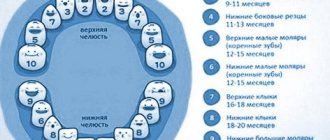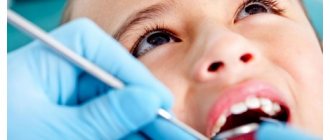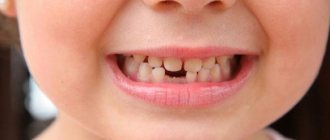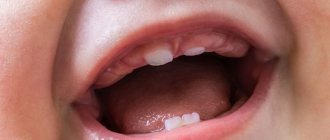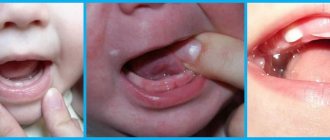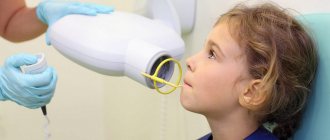Children's teeth appear in a certain sequence and in pairs (for example, two central incisors or two canines). But often the timing of teething in children shifts upward: many parents begin to worry and get nervous, but this is not worth doing, since the deviation from the norm is explained by the individual characteristics of the body, the uncharacteristic course of pregnancy, or various injuries received during childbirth.
Teething in children and features of this process
Quite often, a few weeks before the appearance of a baby or molar tooth, a lump filled with a clear or bluish liquid forms on the gum. Naturally, it worries parents, but there is no pathology in this formation, and the lump, which does not look very aesthetically pleasing, does not indicate the beginning of the inflammatory process. In most cases, no intervention by a doctor is required. You can contact the dentist if the lump increases in size: the doctor will make a small incision and release the liquid.
A child has a lump on his gum - causes and treatment
This section is very important because... will show how untimely dental treatment, parents ignoring changes in the color of baby teeth or their superficial destruction - leads to the rapid development of periodontitis of the baby tooth, against the background of which a purulent abscess forms on the gum. Usually parents believe that they cannot do anything about it, because... The child still won’t let his teeth be treated. But modern dentistry allows even infants to have their teeth treated under sedation, allowing them to sanitize all their teeth in one visit without fear.
Reasons for the appearance of an abscess/bump on the gum –
- Untreated caries of one of the teeth is the main reason for the appearance of such ulcers. Caries in children occurs against the background of irregular hygiene and constant snacking between main meals. Caries sooner or later turns into pulpitis (at this stage, infection from the carious cavity penetrates into the tooth pulp, causing inflammation in it). Inflammation of the pulp leads to the gradual death of the neurovascular bundle inside the tooth - as a result of which a focus of purulent inflammation develops at the apex of the tooth root (apical periodontitis).
- Poorly treated teeth - in public dental clinics, usually no one will bother with your child, persuading him to be patient while the doctor carefully drills out the carious tissue and puts a filling.
Usually, the maximum that dentists offer to children under 3-5 years of age is the method of silvering teeth. But this method only slows down the development of caries and is not a complete treatment method. In addition, silvering of the same tooth must be carried out repeatedly (after a certain time). As a result, in most teeth treated with the silvering method, first pulpitis (inflammation of the nerve in the tooth) always develops, and then periodontitis.
- Traumatic damage to a tooth is the second most common reason why a lump appears on a child’s gum.
A strong mechanical impact on the tooth (fall, bruise, blow) can lead to the death of the nerve in the tooth, and even to a fracture of the crown or root of the tooth. Dental injuries do not always lead to these consequences; for example, if the blow was not very strong, then everything may well end well. If an abscess has nevertheless formed, and there is no caries or filling on the tooth (in the projection of the abscess), then the obvious reason for the development of purulent inflammation will be mechanical trauma to the tooth. This reason will also be supported if you find mobility of the tooth crown (in the projection of the abscess that has formed on the gum), or a change in the color of the tooth crown - to bluish or gray.
How does a purulent abscess form further?
The formation of a purulent abscess on the gum of a child occurs as follows... In general, periodontitis of the tooth for a long time in a child can be asymptomatic, but with hypothermia or decreased immunity, chronic inflammation at the apex of the root worsens - with the formation of pus at the site of inflammation. The pus tends to come out and therefore it gradually “makes” its way through the bone tissue, first falling under the periosteum of the jaw, where a subperiosteal abscess is formed.
Let us recall that the surface of the jaw bone tissue is covered with periosteum, and only on top of the periosteum is the mucous membrane located. When a purulent abscess is located between the surface of the bone and the periosteum, dentists call such inflammation the term “periostitis.” With periostitis, there will be a characteristic swelling on the gum that is dense to the touch, touching which will be very painful (but there will not yet be a clearly contoured lump with pus).
Next, purulent melting of the periosteum may occur, and then pus enters the submucosal membrane, forming a so-called “submucosal abscess.” The mucous membrane has high elasticity, and therefore a “bump”, soft to the touch, with clear contours, filled with pus (usually painless when touched) is formed on the gum. It should also be noted that in parallel with inflammation of the gums, swelling of the soft tissues of the face, as well as lymphadenitis of the submandibular lymph nodes, can also be observed.
Baby teeth in children: order of eruption
Any newborn baby has follicles of milk teeth (20 pieces) and molars (16 pieces) inside the jaws. The remaining 16 rudiments will form later.
Teething in infants begins with the lower jaw: first the central incisors appear (6-10 months of the child’s life), then the canines (10-13 months), then comes the turn of the first (14-18 months) and second (17-23 months) molars .
Emerging teeth differ from adult teeth in having low-mineralized enamel. If you do not maintain oral hygiene, caries may begin to develop. In addition to careful adherence to hygiene rules, special gels and ointments that significantly accelerate the mineralization process will help make teeth stronger and more resistant to pathogenic microorganisms.
How to help a child?
It is impossible to speed up the process of teeth appearing - sometimes it drags on for weeks (for one tooth). The maximum that parents can do is to reduce the number of unpleasant symptoms.
- Vibucol suppositories can be used as a sedative.
- As a pain reliever - children's versions of Nurofen and Panadol.
- As a hygiene product for the oral cavity - gel-based anti-inflammatory toothpastes for children from 0 years old. Asepta Baby paste is designed for little ones. It does not contain fluorides, parabens, or abrasives. Gently cleans teeth, saturating them with calcium. The paste tastes good and is safe - if the child wants, he can swallow it without harm.
Read more about ways to help your baby during teething in other articles in this section.
Approximate timing of eruption of permanent teeth
The first of the molar permanent teeth to appear are molars (at the 6th year of life), located at the end of the dentition. But it is they who are most susceptible to caries, since there are deep depressions on their surface where bacteria accumulate due to poor cleaning and neglect of flossing.
The second molar appears 4-6 years later, when the child reaches 11-13 years of age. Incisors erupt at 6-8 years of a person’s life, canines - after 9 years of age.
Like newly emerged milk teeth, permanent teeth contain few minerals (a tenth of their amount in a mature adult). It is for this reason that it is important to teach a child proper hygiene. It wouldn’t hurt to treat your teeth with gels containing a large amount of fluoride once a quarter.
When do babies' first teeth start to come out?
The table shows at what age children’s first teeth erupt and in what order ( to understand the table, please look at the photo below ):
| Baby's age | Place of cutting |
| 6-7 months | Lower central incisors |
| 8-9 months | Upper central incisors |
| 9-11 months | Upper lateral incisors |
| 11-13 months | Lower lateral incisors |
| 12-15 months | Upper small molars (molars) |
| 12-15 months | Lower small molars (molars) |
| 16-18 months | Upper canines |
| 18-20 months | Lower canines |
| 24-30 months | Lower large molars (molars) |
| 24-30 months | Upper large molars (molars) |
As doctors note, babies’ first teeth begin to emerge at 6-9 months. If the time frame is somewhat delayed, parents should take the child to a pediatrician and dentist. If we talk about the fact that the timing of the appearance of teeth may be atypical, this may indicate certain disorders in the baby’s body:
- if teeth come in 2 months later than normal, this may indicate an infectious disease in the body, a malfunction in metabolic processes and the functioning of the digestive tract;
- when teeth come in 2 months ahead of schedule - this may indicate a malfunction of the endocrine system;
- If the first teeth in infants are cut incorrectly, outside the gum, this indicates an incorrect position of the tooth axis. In this case, surgeons will have to intervene, using special bales and prostheses to guide it correctly.
If there are certain suspicions of pathology or its detection, it is best to show the child to a pediatrician and pediatric dentist.
Teething in children: symptoms
The first signs of the imminent appearance of teeth appear about a week before their appearance. The symptoms will not stop until the tooth breaks through the gum lining.
Signs of teething in a baby are as follows:
- the child becomes irritable for no reason;
- sleep deteriorates (if the child cries at night and tosses and turns, there is no need to immediately start rocking him to sleep - it is better to give the baby the opportunity to calm down on his own);
- the gums become very swollen and swell at the site where the tooth appears;
- the appetite deteriorates, the baby may even refuse to eat altogether, feeling hungry;
- the child begins to chew on various objects to relieve severe itching in the gums;
- salivation increases;
- Due to drooling, a rash may appear around the mouth, chin and chest.
There are also additional ones, i.e. optional symptoms of teething in infants:
- heat. If the temperature has increased, this most likely indicates an inflammatory process that develops in parallel with teething and is in no way connected with it (it could be stomatitis or any cold).
When the temperature rises, you need to carefully examine the oral mucosa. If there are small bubbles filled with a cloudy liquid, erosion, and the gums themselves are bright red, then the child has herpetic stomatitis. Any baby receives antibodies to the herpes virus from its mother, but usually by the time the first teeth appear, their effect ends. Often the catalyzing factor in the development of stomatitis is trauma to the mucous membrane, which is inevitable when teeth appear. If the above signs cannot be detected, then it is recommended to give the baby Panadol (suppositories are the preferred form of medication). As practice shows, it is useless to call a pediatrician, since this is not their specialization. Only a dentist can determine the specific type of stomatitis (aphthous, herpetic, etc.).
- hematomas on the gums. Sometimes the gums become swollen, turning an eerie shade of blue. Despite their frightening appearance, hematomas do not require treatment. Doctor intervention is allowed only for large hematomas that do not decrease over a long time.
- vomit. The only acceptable cause of vomiting is excess saliva entering the stomach and esophagus. If vomiting begins against the background of elevated temperature and, especially, diarrhea, then these symptoms have nothing to do with teething - you need to call a doctor.
- coughing is not a natural cause when teeth appear, unless the child has swallowed saliva that has entered the respiratory tract.
- A runny nose is a sign of a cold, not teething.
Pericoronitis, symptoms and types
With pericoronitis, the symptoms largely depend on the form of the disease - acute or chronic. Acute pericoronitis is characterized by:
- Aching intense pain in the area of the cutting tooth, the pain intensifies under the influence of food and mechanical irritants (hygienic procedures, chewing, touching, etc.).
- Difficulty chewing food, complicated swallowing. A few days after the onset of inflammation, it becomes difficult to open the mouth and severe pain appears.
- Swelling and hyperemia of the mucous membrane.
- Enlargement of regional lymph nodes, sometimes the lymph nodes become painful when touched.
- Externally noticeable swelling of the cheeks a few days after the onset of the inflammatory process.
- General deterioration in health - weakness, lethargy, prolonged low-grade fever (increased temperature to 37-37.5 degrees).
- Bad breath, which is caused by the decomposition of food particles and the active activity of microorganisms in the “hood” space.
Acute pericoronitis can occur in a serous (catarrhal) or purulent form: in the first case, the signs of inflammation are more pronounced, the pain is more intense, and there is no purulent discharge. In the second case, purulent exudate flows freely from the inflammatory focus, due to which tissue tension is somewhat reduced and the symptoms are less pronounced. A person may feel like their condition is gradually improving, when in fact the infection is simply spreading to other tissues in the mouth.
If treatment for acute pericoronaritis was not carried out or was carried out at home, the disease gradually becomes chronic: the severity of symptoms decreases, while exacerbations of pain and discharge of pus into the oral cavity are periodically observed. In this case, there is a high risk of developing severe complications.
Caring for children's teeth
The pattern of teething in children determines the approximate time of their appearance, but it is necessary to start observing oral hygiene as early as possible, without waiting for the teeth to erupt.
Breasts cannot take care of themselves, so they need help cleaning their gums. This is done either with the help of a fingertip, or, if there is none, with the help of an ordinary bandage dipped in warm boiled water and wound around the finger.
If teeth begin to erupt, you cannot do without the use of special products (baby pastes, brushes, etc.).
How to help your baby
If a baby starts teething at 2 months, in addition to fatigue due to sleepless nights, parents feel worried about their baby. Since he suffers from pain, discomfort, eats little and sleeps poorly, it is necessary to help relieve unpleasant symptoms. To do this, use the following methods:
- Massage the gums. You must first wash your hands thoroughly. The massage is done with the tip of your finger. It is worth trimming your nails to avoid damaging your gums. Massaging helps relieve pain. The degree of effectiveness of the method can be determined by the child’s reaction.
- Cold is applied. Regular teethers, which are sold in pharmacies and offered to older children, will not be chewed by a baby at the age of two months. In this case, he can cool the pacifier or apply a gauze pad to the problem area. It is pre-moistened with cold water or chamomile infusion, which helps relieve inflammation.
- Lubricate the gums with anesthetic gels. For example, “Kamistad” or “Kalgel” are products that can be used even at an early age.
- They give antipyretic and painkillers based on ibuprofen and paracetamol. Candles are given to 2-month-old babies. This could be, for example, “Efferalgan”.
During the teething period, it is important to provide the baby with proper care. It is necessary to keep the pacifier clean. Saliva should be wiped off only with clean napkins. The skin around the mouth should be lubricated with a special baby cream. You also need to walk more - fresh air will only do you good. But it is better to avoid places with large crowds of people so that the baby does not catch an additional virus.
If a child’s teeth appear early, if he is breastfed, it is worth visiting a dentist. The fact is that the risk of developing bottle caries in this case is quite high.
Types of teething disorders
Teething in children, the sequence of which is clearly defined, can occur with a delay caused by various reasons (illness of the mother during pregnancy, diseases suffered by the child, etc.). Due to the delay, deformation of the jaws may begin, because There is not enough free space for teeth that have not yet erupted. In this case, only the dentist can decide on treatment after a thorough visual examination of the child and analysis of the photograph taken.
The next very common disorder is enamel hypoplasia, which manifests itself in spots of different colors on newly emerging teeth, pits or grooves. Hypoplasia causes complications during pregnancy.
Diagnostic features
History of the disease Pericoronitis sometimes looks like a completely different disease of the oral cavity - for example, its symptoms can be confused with periodontitis (inflammation of the peri-apical tissues of the oral cavity) or pulpitis (inflammation of the dental pulp). The pain in these diseases is very similar, and periodontitis is often accompanied by hyperemia and swelling of the gums. One disease can be distinguished from another by the following signs: with pulpitis there is no pain when opening the mouth and no noticeable swelling of the gums, and periodontitis develops only at the tops of the roots of fully erupted teeth. You also need to pay attention to the presence of a characteristic “hood” - a photo will help you assess how it looks with pericoronaritis.
Why do teeth erupt with irregularities?
The condition of a child’s teeth in the first years of life depends on the health of the mother during pregnancy. The formation of hard dental tissues may be disrupted if a woman:
- suffered from toxicosis at the initial stage of pregnancy;
- experienced severe prolonged stress;
- was treated for kidney disease;
- suffered from rubella.
In addition to maternal diseases, the maturation of teeth and the development of the jaw system can be affected by:
- fetal prematurity or, conversely, delayed birth;
- conflict of Rh factors;
- sepsis suffered by a child in the first month of life;
- frequent colds, pneumonia;
- convulsions;
- toxicosis;
- refusal to breastfeed.
Often, parents, driven by the best intentions, want to alleviate the baby’s suffering by giving him medications. You must understand that any medicine, even if it seems completely safe, cannot be taken without consulting a pediatrician!
How to relieve your baby's condition with medications
If your baby is bothered by sore gums and begins to behave restlessly, you can give him a mild pain reliever that is appropriate for his age.
For the youngest, it is better to use candles, and older children can be given a special suspension. These drugs, in addition to a sedative effect, have mild antipyretic properties. In addition, pharmacies sell a special anesthetic gel, a small amount of which should be applied to the surface of the inflamed gum. However, you should not get carried away with such gels, since most of them promote increased salivation and also cause numbness, which makes the baby feel uncomfortable.
Important:
Before purchasing one or another medication to alleviate a child’s teething condition, you should definitely consult a pediatrician to rule out side effects.
White spots on enamel: what are they?
More often, white spots appear on baby teeth, less often on permanent teeth. Experts divide them into two classes:
- carious - those that are associated with the development of caries;
- non-carious.
White areas on the enamel indicate its demineralization. A whitish line may also appear at the edge of the gums of the front teeth. In any case, consultation with a doctor is required.
Compared to permanent teeth, baby teeth are more susceptible to caries. Their enamel is thin and porous, which allows bacteria to easily penetrate inside. The disease progresses quickly, so in a short period of time there may be nothing left of the tooth. There is a risk of damage to the “successor” rudiments. These facts refute the opinion of some parents that there is no need to treat baby teeth, since they must be replaced.
Teeth cutting at 3 months: what parents need to know
Noticing changes in behavior and deterioration in the baby’s well-being, parents wonder whether teething can occur at 3 months. Although such timing is not typical, it is worth knowing that the appearance of incisors at this age is possible. By the way, there are rare cases when a child is already born with teeth.
Deviations in both directions from the average time frame are considered normal. Each child's body is individual. In addition, various factors influence the timing of eruption:
- during pregnancy - the milk bite is formed in the womb at 7–8 weeks;
- mother's diet - consumption of fermented milk products in large quantities by the pregnant woman promotes rapid teething;
- additional intake of mineral complexes - in particular vitamin D and C;
- genetic predisposition to early teething;
- climatic conditions - the process of teething begins earlier among residents of the south.
In some cases, early tooth growth may indicate pathology, in particular endocrine system disorders. But it is believed that it is not the timing that speaks about the healthy development of the baby. It matters what kind of teeth come in. It is important that the order in which they appear is observed. The central teeth grow first from below, followed by their antagonists from above. Then the lateral incisors appear, followed by the canines (first the upper, then the lower). The last to be cut are the molars on the lower and upper jaws.
